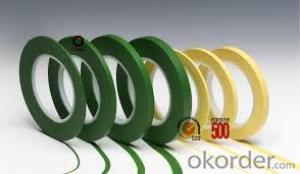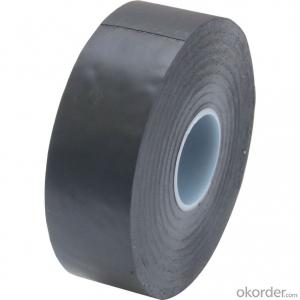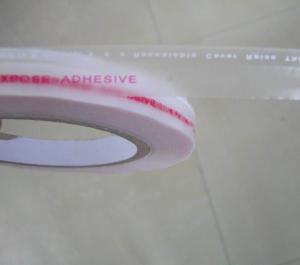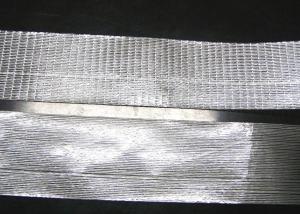Custom Black Packaging Tape - Insulating Polyimide Film Silicone Sealing Tapes
- Loading Port:
- Tianjin
- Payment Terms:
- TT OR LC
- Min Order Qty:
- 1000 roll
- Supply Capability:
- 500000 roll/month
OKorder Service Pledge
OKorder Financial Service
You Might Also Like
1.Product details
| Item Name | Item No. | Carrier | Adhesive Type | Total Thickness (mm) | Dimension (mm X m) | Color | Heat resistance |
| Single sided polyimide tape | HS-201#25 | Polyimide film | Silicone Adhesive | 0.06 | 500 X 33 | Amber | 260℃ |
| HS-201#35 | Polyimide film | Silicone Adhesive | 0.06 | 500 X 33 | Amber | 260℃ | |
| HS-201#50 | Polyimide film | Silicone Adhesive | 0.075 | 500 X 33 | Amber | 260℃ | |
| HS-201#75 | Polyimide film | Silicone Adhesive | 0.11 | 500 X 33 | Amber | 260℃ | |
| HS-201B | Polyimide film | Acrylic Adhesive | 0.06 | 500 X 33 | Amber | 130℃ |
2.Packaging & Delivery
Packaging Details:
Silicone Polyimide Tape:
460mm x 350mm X 360mm cartons or Customized Package
Delivery Detail:
Shipped in 7 days after payment
3.FAQ
Q: What kind of payments does jenor support?
A: T/T, L/C, Cash are accepted.
Q: Do you charge for the samples?
A: Accordeing to our company policy, the samples are free, we only charge the freight fee. And we will return the freight fee during the next order.
Q: Can you produce according to customers' design?
A: Sure, we are professional manufacturer, OEM and ODM are both welcome.
4.product show




5.Our services
1.OEM Service
Your own design is appreciated; we can make the approval sample according to your golden sample.
2. QC Service
a) Before the order to be confirmed, we should check the material & color of fabric by sample which should be strictly.
b) We will be tracing the different phase of production from the beginning.
c) Every bad quality will be checked & cleaned before packing.
d) Before delivery clients could send one QC or point the third party to check the quality.
e) We will try our best to help clients when problem occurred.
3. After-sale Service
a) EXW, FOB, C&F are also available for us.
b) If the products need certificate, we can also provide.
- Q: Can packaging tape be used for outdoor applications?
- Yes, packaging tape can be used for outdoor applications. However, it is important to choose a tape specifically designed for outdoor use, as it needs to be weather-resistant and durable to withstand various environmental conditions such as rain, sunlight, and temperature fluctuations.
- Q: Is packaging tape heat resistant?
- Yes, packaging tape is typically heat resistant. Most packaging tapes are made from materials such as polypropylene or vinyl, which can withstand moderate temperatures without melting or losing their adhesive properties. However, it is important to check the specific specifications and limitations of the packaging tape you are using to ensure it is suitable for your intended application.
- Q: Can packaging tape be used for bundling items together?
- Yes, packaging tape can be used for bundling items together.
- Q: How does packaging tape perform on high-gloss surfaces?
- Packaging tape performs well on high-gloss surfaces. The adhesive used in packaging tape is designed to stick to a variety of materials, including glossy surfaces such as plastic, glass, or coated paper. The tape provides a strong bond, ensuring that the package remains securely sealed. It adheres firmly to the high-gloss surface, preventing the tape from peeling off or sliding around during transport or storage. Additionally, packaging tape is typically resistant to moisture, which further enhances its performance on glossy surfaces. Overall, packaging tape is a reliable choice for sealing packages on high-gloss surfaces, providing a secure and professional packaging solution.
- Q: Can packaging tape be used for sealing packages with perishable food items?
- No, packaging tape is not suitable for sealing packages with perishable food items as it does not provide an airtight seal or protect against moisture, which can lead to spoilage and potential health risks. It is recommended to use specialized food-grade packaging materials designed for perishable items to ensure their freshness and safety.
- Q: When the box is sealed, the tape is very noisy and very harsh. What shall I do?
- General adhesive tape is a taste, the size of the taste depends on the formula of glue, low molecular weight content, taste will be larger, once adhesive tape, it has a very small taste tape, we have been using.
- Q: How do I prevent packaging tape from becoming brittle?
- In order to avoid packaging tape from becoming brittle, there are several steps that can be taken: 1. Proper storage is key. Ensure that the packaging tape is stored in a cool and dry location, away from direct sunlight. Extreme temperature fluctuations can lead to tape brittleness, so it is important to maintain a consistent environment to prolong its lifespan. 2. Excessive tension should be avoided when applying the tape. It is best not to stretch the tape too tightly or apply excessive pressure, as this can strain the adhesive and cause it to lose flexibility, resulting in brittleness. 3. Selecting the appropriate tape is essential. Different types of packaging tapes have varying levels of durability. Depending on your specific needs, choose a tape that is specifically designed for heavy-duty or long-term use. These tapes often have stronger adhesives and materials that are less prone to becoming brittle. 4. Handle the tape with care during use. It is important to handle the tape gently to avoid unnecessary stress. Pulling or tugging forcefully on the tape can weaken its structure and lead to brittleness. 5. Replace old tape when necessary. If you notice that your packaging tape has started to become brittle or lose its adhesive strength, it is best to replace it with fresh tape. Using old and brittle tape may compromise the security of your packaging, increasing the risk of it breaking or coming undone during transit. By following these preventive measures, you can help maintain the flexibility and durability of your packaging tape, ensuring it remains reliable for your packaging needs.
- Q: Can packaging tape be used for sealing vinyl flooring?
- No, packaging tape should not be used for sealing vinyl flooring. Vinyl flooring requires a specific type of adhesive designed for flooring applications. Using packaging tape may not provide the necessary durability and protection required for vinyl flooring. It is recommended to use a vinyl flooring adhesive or a compatible adhesive recommended by the manufacturer for the best results.
- Q: Can packaging tape be used for sealing protective packaging materials like bubble wrap?
- Yes, packaging tape can be used for sealing protective packaging materials like bubble wrap. Packaging tape is designed to provide a strong and secure seal on various types of materials, including bubble wrap. It is commonly used in packaging and shipping industries to ensure that the contents of a package are well-protected and secure during transit. When using packaging tape to seal bubble wrap, it is important to apply the tape along the edges of the bubble wrap to create a tight seal and prevent any potential damage or exposure.
- Q: Does packaging tape come in different dispenser designs for ergonomic use?
- Different dispenser designs for ergonomic use are available for packaging tape. Various manufacturers offer dispenser options that are specifically created to provide comfort and ease of use during extended periods of usage. These designs often incorporate features like cushioned handles, ergonomic grips, and adjustable tension control to minimize strain and fatigue on the hand and wrist. Moreover, certain dispensers may possess a lightweight and compact design, making them more manageable and maneuverable. The objective of these ergonomic dispenser designs is to enhance productivity and lower the likelihood of injuries or discomfort commonly associated with repetitive tape dispensing tasks.
Send your message to us
Custom Black Packaging Tape - Insulating Polyimide Film Silicone Sealing Tapes
- Loading Port:
- Tianjin
- Payment Terms:
- TT OR LC
- Min Order Qty:
- 1000 roll
- Supply Capability:
- 500000 roll/month
OKorder Service Pledge
OKorder Financial Service
Similar products
Hot products
Hot Searches





























